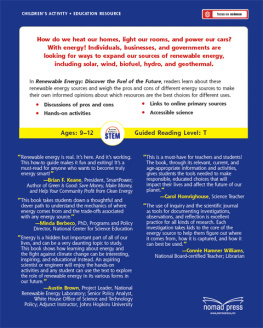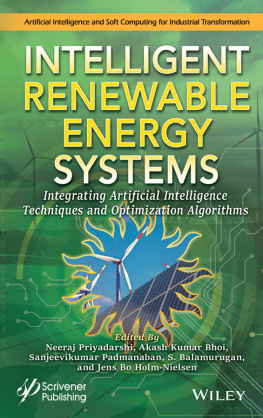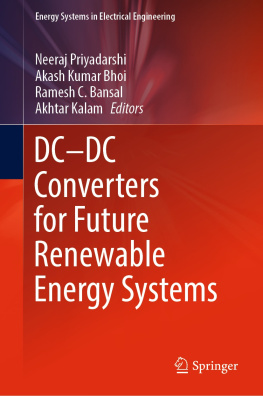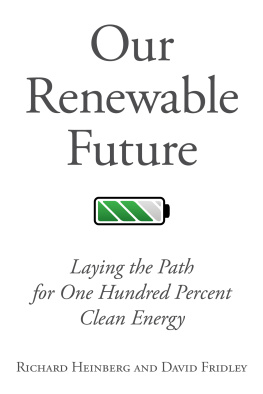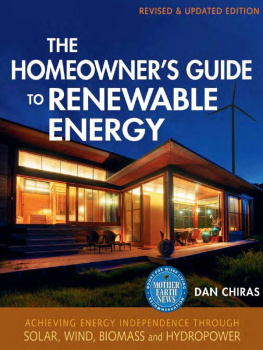David Infield - Renewable energy in power systems
Here you can read online David Infield - Renewable energy in power systems full text of the book (entire story) in english for free. Download pdf and epub, get meaning, cover and reviews about this ebook. year: 2020, publisher: Wiley, genre: Romance novel. Description of the work, (preface) as well as reviews are available. Best literature library LitArk.com created for fans of good reading and offers a wide selection of genres:
Romance novel
Science fiction
Adventure
Detective
Science
History
Home and family
Prose
Art
Politics
Computer
Non-fiction
Religion
Business
Children
Humor
Choose a favorite category and find really read worthwhile books. Enjoy immersion in the world of imagination, feel the emotions of the characters or learn something new for yourself, make an fascinating discovery.

- Book:Renewable energy in power systems
- Author:
- Publisher:Wiley
- Genre:
- Year:2020
- Rating:3 / 5
- Favourites:Add to favourites
- Your mark:
- 60
- 1
- 2
- 3
- 4
- 5
Renewable energy in power systems: summary, description and annotation
We offer to read an annotation, description, summary or preface (depends on what the author of the book "Renewable energy in power systems" wrote himself). If you haven't found the necessary information about the book — write in the comments, we will try to find it.
Renewable energy in power systems — read online for free the complete book (whole text) full work
Below is the text of the book, divided by pages. System saving the place of the last page read, allows you to conveniently read the book "Renewable energy in power systems" online for free, without having to search again every time where you left off. Put a bookmark, and you can go to the page where you finished reading at any time.
Font size:
Interval:
Bookmark:
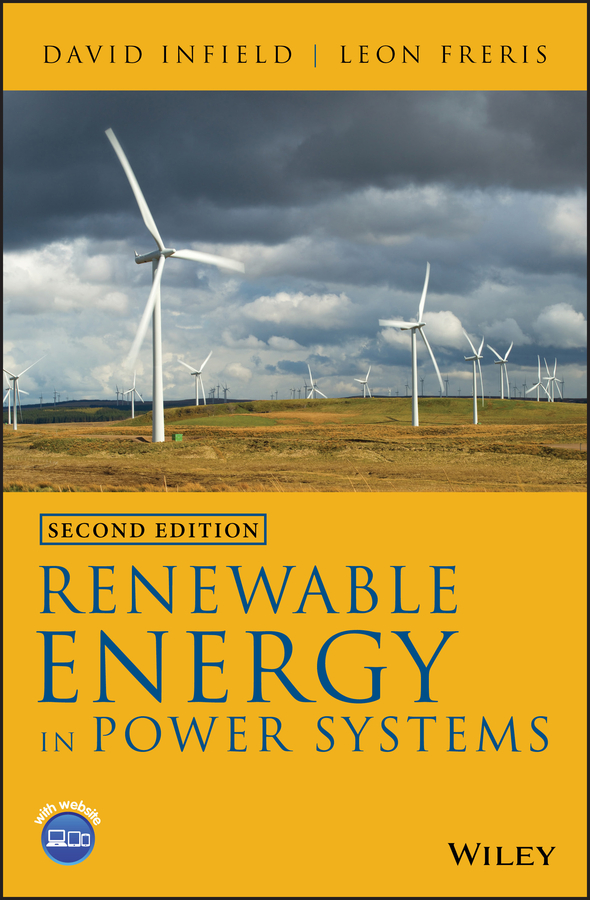
- Chapter 1
- Chapter 2
- Chapter 3
- Chapter 4
- Chapter 5
- Chapter 6
- Chapter 7
- Chapter 8
- Chapter 1
- Chapter 2
- Chapter 3
- Chapter 4
- Chapter 5
- Chapter 6
- Chapter 7
- Chapter 8
- Appendix A
David Infield
Department of Electronic and Electrical Engineering
University of Strathclyde
Glasgow, UK
Leon Freris
Centre for Renewable Energy Systems Technology (CREST)
Loughborough University
Leicestershire, UK
Second Edition

This edition first published 2020
2020 John Wiley & Sons Ltd
Edition History
John Wiley & Sons Ltd (1e, 2008)
All rights reserved. No part of this publication may be reproduced, stored in a retrieval system, or transmitted, in any form or by any means, electronic, mechanical, photocopying, recording or otherwise, except as permitted by law. Advice on how to obtain permission to reuse material from this title is available at http://www.wiley.com/go/permissions.
The right of David Infield and Leon Freris to be identified as the authors of this work has been asserted in accordance with law.
Registered Offices
John Wiley & Sons, Inc., 111 River Street, Hoboken, NJ 07030, USA
John Wiley & Sons Ltd, The Atrium, Southern Gate, Chichester, West Sussex, PO19 8SQ, UK
Editorial Office
The Atrium, Southern Gate, Chichester, West Sussex, PO19 8SQ, UK
For details of our global editorial offices, customer services, and more information about Wiley products visit us at www.wiley.com.
Wiley also publishes its books in a variety of electronic formats and by print-on-demand. Some content that appears in standard print versions of this book may not be available in other formats.
Limit of Liability/Disclaimer of Warranty
In view of ongoing research, equipment modifications, changes in governmental regulations, and the constant flow of information relating to the use of experimental reagents, equipment, and devices, the reader is urged to review and evaluate the information provided in the package insert or instructions for each chemical, piece of equipment, reagent, or device for, among other things, any changes in the instructions or indication of usage and for added warnings and precautions. While the publisher and authors have used their best efforts in preparing this work, they make no representations or warranties with respect to the accuracy or completeness of the contents of this work and specifically disclaim all warranties, including without limitation any implied warranties of merchantability or fitness for a particular purpose. No warranty may be created or extended by sales representatives, written sales materials or promotional statements for this work. The fact that an organization, website, or product is referred to in this work as a citation and/or potential source of further information does not mean that the publisher and authors endorse the information or services the organization, website, or product may provide or recommendations it may make. This work is sold with the understanding that the publisher is not engaged in rendering professional services. The advice and strategies contained herein may not be suitable for your situation. You should consult with a specialist where appropriate. Further, readers should be aware that websites listed in this work may have changed or disappeared between when this work was written and when it is read. Neither the publisher nor authors shall be liable for any loss of profit or any other commercial damages, including but not limited to special, incidental, consequential, or other damages.
Library of Congress Cataloging-in-Publication Data
Names: Infield, D. G., author. | Freris, L. L., author.
Title: Renewable energy in power systems / David Infield, Leon Freris.
Description: Second edition. | Hoboken : Wiley, 2020. | Includes bibliographical references and index.
Identifiers: LCCN 2019030493 (print) | LCCN 2019030494 (ebook) | ISBN 9781118649930 (cloth) | ISBN 9781118788585 (adobe pdf) | ISBN 9781118788561 (epub)
Subjects: LCSH: Renewable energy sources.
Classification: LCC TJ808 .F76 2019 (print) | LCC TJ808 (ebook) | DDC 621.042--dc23
LC record available at https://lccn.loc.gov/2019030493
LC ebook record available at https://lccn.loc.gov/2019030494
Cover Design: Wiley
Cover Image: photography by Spencer Bowman/Getty Images
Congratulations! By holding this book (or e-read equivalent) in your hands, you are very likely showing an interest in the engineering of renewable energy concepts. (And well done, too, on reading a Foreword, most people, including myself, jump straight into the technical chapters but that's another story.)
I want to urge you to keep that interest in renewable energy going. When I studied electrical engineering in the 1980s, anything renewable (wind, solar, and to some degree hydro) was classified by many scholars, industry practitioners and stakeholders as Alternative Energy. Alternative to the might of having a standardised high voltage and low voltage grid network that delivered electricity to homes and factories from bulk sources such as coal, oil, gas and nuclear power stations. We had some hydro but this was pretty much exclusively used for peak demand management and frequency control, and virtually no other renewable energy sources existed at scale. That Alternative badge pretty much also made anyone who was trying to explore renewable sources be tagged as anything from non-mainstream to tree hugging to just plain crazy. It was difficult to be different and to do anything other than the decades old ways of generating and delivering electricity. To be fair, this was for good reason, of course when the paying of your energy bills formed a significant part of just about everyone's income it was often the cheapest way of generating electricity and delivering it reliably to consumers. Implementing significant change was deemed difficult and costly. It was easier to move in straight lines.
Now, we are in a very different age. I'm pleased the term consumer has almost gone, and has been replaced with the word customer. The production and sale of electricity is now much more competitive and customer value is replacing monopoly product and service. Regrettably, the world still has millions of people struggling to afford to pay for energy and so the changes we want to make to improve our environment must continue to take affordability into account. Often, this requires innovative ways of doing things, finding new solutions to use existing infrastructure and challenging the age-old engineering and regulatory norms that dominate power systems around the world.
Further, the steady realisation that those who warned about the effects of noxious gases that created acidic rain, and then CO2 contributing to climate change, were actually right as opposed to crazy, has led to global legislation to do something about it. Renewable energy, particularly wind and solar power, has made great strides. The Alternative Energy world is on a journey to becoming far more mainstream. There will always be some who deny climate change, of course. Nevertheless, what is indisputable is that fossil fuels are finite, and it's better, in my view, to generate power using sustainable resources and to either leave our fossil fuels alone or at least find far more efficient, non-polluting uses for them.
Next pageFont size:
Interval:
Bookmark:
Similar books «Renewable energy in power systems»
Look at similar books to Renewable energy in power systems. We have selected literature similar in name and meaning in the hope of providing readers with more options to find new, interesting, not yet read works.
Discussion, reviews of the book Renewable energy in power systems and just readers' own opinions. Leave your comments, write what you think about the work, its meaning or the main characters. Specify what exactly you liked and what you didn't like, and why you think so.

